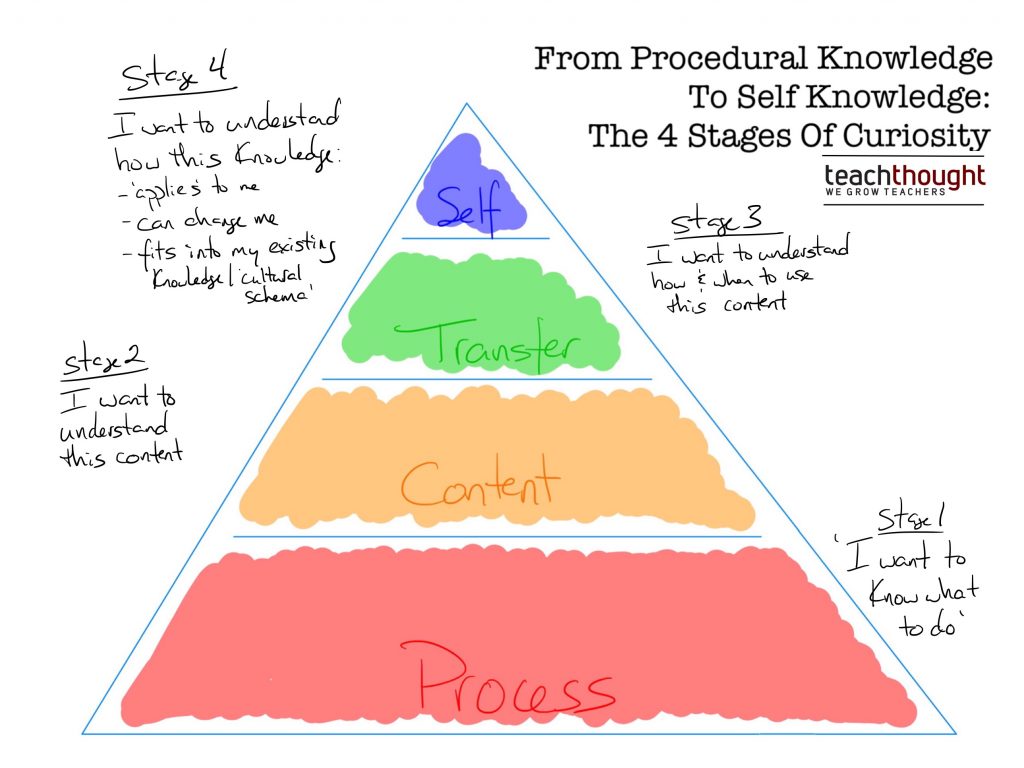
What Are The 4 Stages Of Curiosity?
by Terry Heick
Where curiosity comes from isn’t entirely clear.
In fact, it isn’t even easy to define. That’s probably because there is no single source for it any more than there is a single source for entertainment, anxiety, or confidence.
There are strategies to promote curiosity in the classroom—even those that consider how the brain works. Ideally, teaching and learning wouldn’t benefit from having curiosity ‘added in,’ but rather would fail completely without it.
There is also no single ‘look’ for curiosity, much less four clear and universal stages of curiosity. The things teachers often look for as indicators of student engagement—waving hands in the air, locked eye contact, or good grades on tests—may not be the result of curiosity at all.
What are the stages of curiosity? Below we take a look at the idea. Also, note that these indicators don’t always represent curiosity and engagement—they could be thoughtless habit or external coercion. In the same way, behaviors indicating lower levels of curiosity don’t necessarily mean the student is disengaged and uncurious. The lesson design could be confusing, or the materials used could be poorly-written, above their reading level, or otherwise misleading.
For this reason (and others), teachers are always encouraged to take a broad and holistic view of each student that incorporates habits over time, personality, and the ebbs and flow of growing up! Also, certain learner ‘needs’ at one stage may also exist at another. These are merely suggestions that can characterize most closely a student’s ‘need to know.’
4 Stages Of Curiosity
Stage 1: Process
Stage 2: Content
Stage 3: Transfer
Stage 4: Self
From Procedural Knowledge To Self Knowledge: The 4 Stages Of Curiosity
Stage 1: Process
Student mindset: “Tell me what to do.”
This is the first level of curiosity and engagement, where students are primarily concerned with procedural knowledge—teacher expectations, their role, interaction with peers, task sequence, etc. Included here is their own survey of the activity to highlight areas they may like or dislike, or be prepared or unprepared to complete.
All learners typically begin here as they try to make sense of a given task or activity. Ideally, they’d start here and quickly graduate to the next level, but for some this may be their first and last stage without your intervention.
Learner needs at this stage: Prompting, repeating instructions more than once, clarifying instructions with paraphrasing, instructions in multiple forms (verbal, on-screen or board, on a handout, etc.)
Stage 2: Content
Student mindset: “This is interesting. I’d like to learn more.”
Following the Process Stage is the Content Stage of curiosity and engagement.
This stage unsurprisingly has content at its core. In traditional academic environments, this could be topics of study, conversation, research, or related opportunities. Students no longer have the compelling big ideas of content obscured by instructions, activity design, or confusing–or well-intentioned but unnecessary in the face of budding curiosity–teacher directions.
In fact, the teacher’s role could be significantly reduced compared to Stage 1, which allows the interaction between the learner and content to be perhaps less neat and efficient, but more authentic and direct–resulting in a better feedback loop for learning.
Learner needs at this stage: Content at appropriate reading level, compelling content, tasks that balance of consumption and production, choice and voice in their work (which is true at any stage)
Stage 3: Transfer
Student mindset: “Move out of my way–but not too far.”
At this stage of curiosity, students begin to seamlessly connect knowledge, assimilating what they’re learning into what they already know. This can lead to types of transfer, where they—unprompted and without any cueing—transfer what they know from heavily-scaffolded and supported situations, to new and unfamiliar situations.
Learners at this level of curiosity may demand both direction and freedom at the same time as they seek to direct their own learning in new contexts, while sometimes lacking the frameworks, ideas, or strategies to do so.
Learner needs at this stage: Flexible rubrics, scoring guides that promote creativity, open-ended learning models (e.g., project-based learning), self-directed learning strategies
Stage 4: Self
Student mindset: “This has changed me.”
At the ‘Self’ Stage of curiosity and engagement, students move past mere transfer to make sense of changes—and possible opportunities–in themselves as the result of learning. This is closely related to the Transfer Level, which makes sense as students will naturally transition knowledge to familiar schema—circumstances or situations they have experience with.
This is the most powerful level of curiosity not simply because of knowledge assimilations and transfer, but how it can change the student’s reasons for learning, and their own role in the learning process. At this level, students ask questions unprompted, can imagine learning pathways that aren’t suggested to them, and constantly seek to reconcile what they do and don’t know without prompting and prodding.
In fact, a learner at this level will benefit from support, tools, models, and collaboration more than they might with direct instruction, rigid rubrics
Learner needs at this stage: Exemplar models, dynamic tools, strategic collaboration, cognitive and emotional coaching, space
From Procedural Knowledge To Self Knowledge: The 4 Stages Of Curiosity
